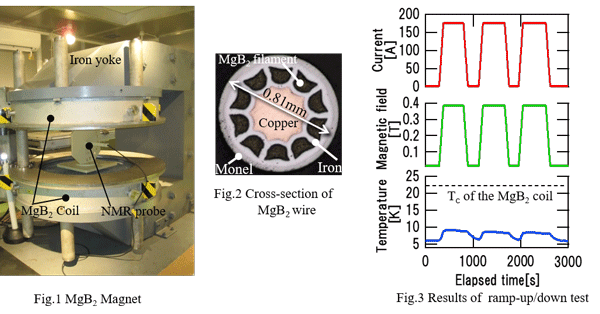AP2-5-INV
Development of fast on/off MgB2 magnet
Dec.1 14:40-15:10 (Tokyo Time)
Research & Development Group, Hitachi Ltd.1
Magnesium diboride (MgB2), which can operate under helium-free conditions below 20 K, shows good potential for application to a conduction-cooled superconducting magnet. Its higher temperature margin compared to NbTi will provide added value such as a fast on/off magnetic field enabled by faster ramp-up/down, which makes it applicable to mobile MRI and intraoperative MRI [1]. In this presentation, we report the results of a ramp-up/down test and preliminary magnetic resonance (MR) imaging test we performed using a MgB2 magnet. The MgB2 magnet was composed of a C-shaped iron yoke and two MgB2 coils fabricated by a wind & react method (Fig. 1). Two MgB2 coils were conduction-cooled by two 4K-GM cryo-coolers. The load factor (operating current: 167 A / critical current: 308 A) was 54% at the temperature of 15 K. We used MgB2 wires constructed by an in-situ PIT method that had ten MgB2 filaments twisted with a 200 mm pitch [2] (Fig. 2). In the ramp-up/down test, the ramp-up rate was 2 A/s, and a 0.4 T magnetic field was generated within 85 sec (Fig. 3). The rise of coil
temperature was about 3 K and the magnet had a sufficient temperature margin for the critical temperature of 22 K. The long-time stability of the magnetic field was 0.2 ppm/hr, which is a sufficient performance for MR imaging.
[1]Yrjänä SK, Katisko JP, Ojala RO, Tervonen O, Schiffbauer H, Koivukangas J. Versatile intraoperative MRI in neurosurgery and radiology. Acta Neurochir (Wien). 2002;144(3):271-278.
[2] Tanaka H, Kodama M, Ichiki Y, Kusunoki T, Kotaki H, Suzuki T, Nishi K and Okamoto K 2017 IEEE Trans. Appl. Superocond. 27 4600904
Acknowledgement: This work was supported by Dr. Nishijima of the National Institute for Materials Science (NIMS).
Keywords: MgB2 magnet
